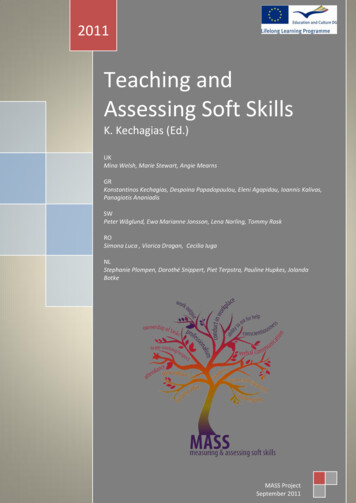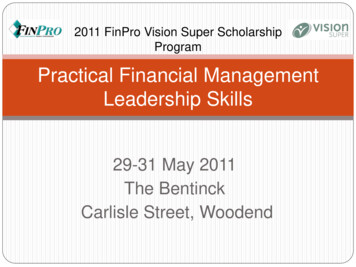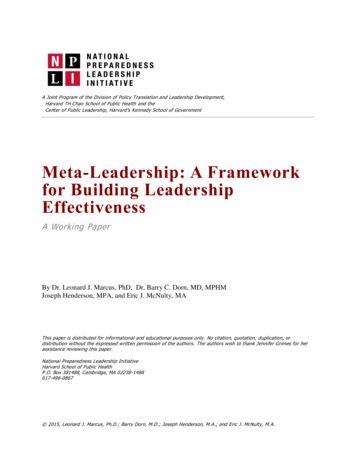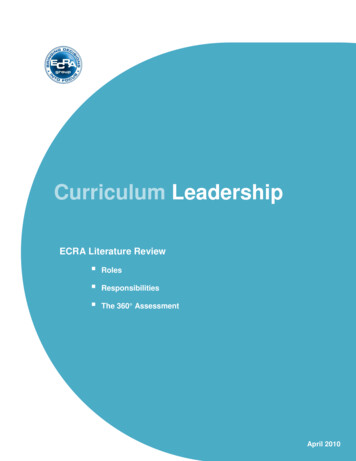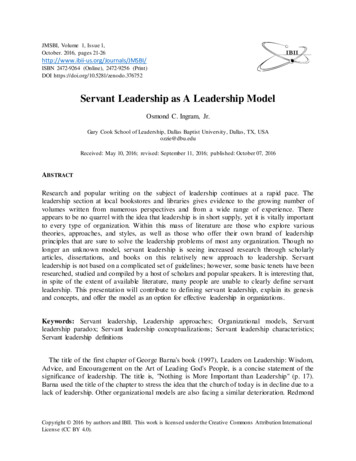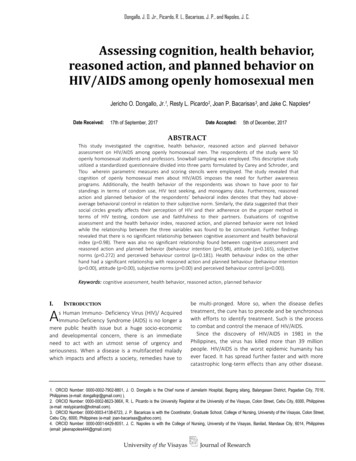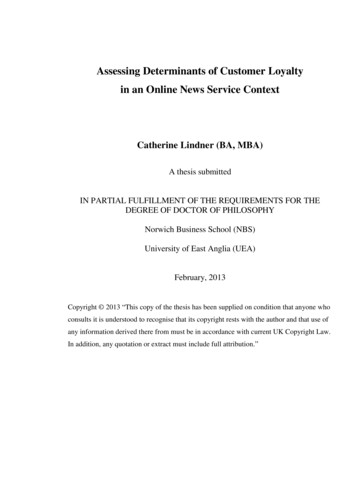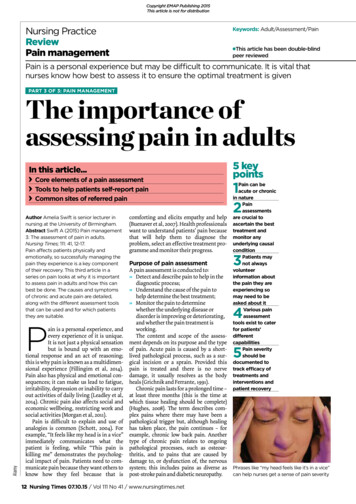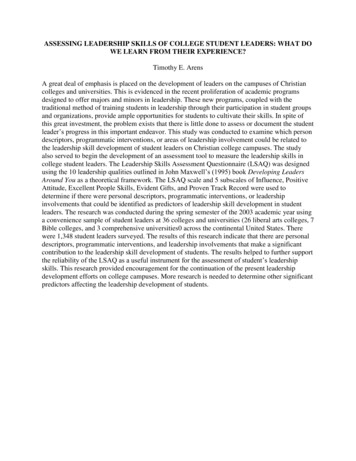
Transcription
ASSESSING LEADERSHIP SKILLS OF COLLEGE STUDENT LEADERS: WHAT DOWE LEARN FROM THEIR EXPERIENCE?Timothy E. ArensA great deal of emphasis is placed on the development of leaders on the campuses of Christiancolleges and universities. This is evidenced in the recent proliferation of academic programsdesigned to offer majors and minors in leadership. These new programs, coupled with thetraditional method of training students in leadership through their participation in student groupsand organizations, provide ample opportunities for students to cultivate their skills. In spite ofthis great investment, the problem exists that there is little done to assess or document the studentleader’s progress in this important endeavor. This study was conducted to examine which persondescriptors, programmatic interventions, or areas of leadership involvement could be related tothe leadership skill development of student leaders on Christian college campuses. The studyalso served to begin the development of an assessment tool to measure the leadership skills incollege student leaders. The Leadership Skills Assessment Questionnaire (LSAQ) was designedusing the 10 leadership qualities outlined in John Maxwell’s (1995) book Developing LeadersAround You as a theoretical framework. The LSAQ scale and 5 subscales of Influence, PositiveAttitude, Excellent People Skills, Evident Gifts, and Proven Track Record were used todetermine if there were personal descriptors, programmatic interventions, or leadershipinvolvements that could be identified as predictors of leadership skill development in studentleaders. The research was conducted during the spring semester of the 2003 academic year usinga convenience sample of student leaders at 36 colleges and universities (26 liberal arts colleges, 7Bible colleges, and 3 comprehensive universities0 across the continental United States. Therewere 1,348 student leaders surveyed. The results of this research indicate that there are personaldescriptors, programmatic interventions, and leadership involvements that make a significantcontribution to the leadership skill development of students. The results helped to further supportthe reliability of the LSAQ as a useful instrument for the assessment of student’s leadershipskills. This research provided encouragement for the continuation of the present leadershipdevelopment efforts on college campuses. More research is needed to determine other significantpredictors affecting the leadership development of students.
THE IMPACT OF A PSYCHOLOGICAL CAPITAL INTERVENTIONON COLLEGE STUDENT WELL-BEINGLeslie Vaccarello BaumanDoctor of Philosophy in Higher Education, 2014Azusa Pacific UniversityAdvisor: Laurie A. Schreiner, Ph.D.Enhancing students’ strengths and psychological resources provides an opportunity to addressthe precipitous rise in the prevalence of psychological problems on college campuses. Thisstudy assessed the effectiveness of a brief intervention focused on building students’Psychological Capital (PsyCap; Luthans, Youssef, & Avolio, 2007), comprised of hope,resilience, optimism, and efficacy to provide students with useful tools and techniques thatwould positively impact their psychological well-being. Using an experimental posttest-onlywaiting-list control group design, 41 students from a private, faith-based institution wererandomly assigned to either a treatment (N 19) or a control (N 22) condition. Students in thetreatment condition participated in an intervention composed of 2 face-to-face 60-minutesessions. The dependent variable was students’ scores on Ryff’s (1989b) psychological wellbeing scales, comprised of self-acceptance, positive relations with others, autonomy,environmental mastery, purpose in life, and personal growth. A MANCOVA with pretestPsyCap scores as covariates was conducted to determine treatment fidelity and providedevidence that participants in the treatment condition scored significantly higher in PsyCap and itscomponents of hope, efficacy, resilience and optimism after the intervention than did the controlgroup (Wilks’ Ʌ .633, F(4, 32) 4.635, p .01, partial η2 .367). A MANCOVA to assessthe effect of the intervention on hope, resilience, optimism, efficacy, and psychological wellbeing demonstrated that although there was a significant multivariate effect (Wilks’ Ʌ .507,F(10, 26) 2.526, p .05, partial η2 .493), there were no significant group differences in totalpsychological well-being scores as a result of the intervention. However, univariate analysesrevealed that the intervention significantly affected students’ scores on the environmentalmastery aspect of psychological well-being, as well as their psychological capital, hope,resilience, and optimism; and this effect was relatively sustained over time. The majorimplication for practice is that a brief PsyCap intervention can bolster students’ ability to managetheir time, resources, and environmental challenges during the college years, enablinginstitutions to provide preventive tools through advising, the co-curriculum, and outreachprograms to enhance psychological well-being.
EFFECTIVE LEADERSHIP IN ETHIOPIA: PERCEIVED NEEDS OF PROMINENTETHIOPIAN LEADERS TO DEMONSTRATE EFFECTIVE IN THE COUNTRY ANDTHE FORMATION OF A RELEVANT LEADERSHIP PROGRAM TO MEET THENEEDBadeg BekeleDoctor of Education in Educational Leadership, 2005Azusa Pacific UniversityAdvisor: Dr. Dave McIntire, Ed.D.When high responsibility is placed on leaders, there is a natural tendency for leaders to makeefforts to meet the expectations. When that happens, leaders are more conscious and focus todemonstrate effectiveness in their organizations. Prominent Ethiopia leaders are not differentfrom this reality. When a responsibility was placed by a higher body to run top level leadershipoffices, they try to make every effort to bring change and progress in their organizations. Thisdissertation explores the perceived needs of prominent Ethiopian leaders to demonstrate effectiveleadership in the country. These leaders are identified from government, nongovernmental,business and church communities to help understand their needs. The study outcome is intendedto contribute to the formation of a leadership development training program in the country. Aphenomenological qualitative approach is used to understand the lived experience of theseleaders. The findings of this study reveal the leadership need of the participants as they took theirleadership responsibility in their organizations. The need expressed goes beyond their needs andaddresses the leadership needs of future leaders in general. There are suggestions offered towardthe formation of a relevant leadership program in the country. The conclusion of this studyfocuses on leadership needs of prominent leaders, needs of future leaders and recommendation tothe formation of a leadership program in the country. The study outcome also reveal that thereare needs that can be met by formal education, by short-term training and by consultancy serviceto help leaders define their needs before designing a training to meet it. There are prioritiesidentified for the purpose of training needs by the study participants.
THE IMPACT OF SUMMER INTERNATIONAL SHORT-TERM MISSIONSEXPERIENCES ON THE CROSS-CULTURE SENSITIVE OF UNDERGRADUATECOLLEGE STUDENT PARTICIPATIONSPaul BlezienThe research conducted for this study attempted to answer this question: To what extent, if any,is the cross-cultural sensitivity of undergraduate college students influenced by participation insummer international short-term mission experiences? The literature review examined summershort-term missions and cross-cultural sensitivity though there was little research literature thatlinks the two. Both qualitative and quantitative research methodologies were employed to answerthe research question. The quantitative portion of the research involved pretests and posttests of159 students from five different Christian colleges that are members of the Council for ChristianColleges and Universities. The instrument utilized in this portion of the study was the entireQuick Discrimination Index (Ponterotto & Bukard, 1195; Utsey & Ponterotto, 1999) and aportion of the Crown-Mueller (1960) Social Desirability Scale. A control group of 151 studentsalso completed the pretest and posttest. Appropriate statistical techniques were used to determineif there were any significant changes in the cross-cultural sensitivity of the summer short-termmissions participants. Other independent variables that were considered include sex, age, familyincome, political orientation, school attended, length of project, and previous international travel.Four independent variables were found to be statistically significant predictors of posttest scores.Generally speaking, the higher the posttest scores were achieved by students claiming to bepolitically liberal, possessing more experience with overseas travel, female, and younger in age.The qualitative portion of the research involved three separate inquiries. There were photojournaling, open-ended survey questions on the posttest, and photo elicitation interviews.Qualitative findings included themes of actual impact and stimuli for the impact. It was clear thatstudents’ understanding of God and their relationship with Him was enhanced. They alsoreported being impacted cross-culturally in both cognitive and affective ways. Students felt thattheir values and long term mission calling were also clarified. Catalysts for impact includedrelationships formed during the service, exposure to the host culture, moments of crisis, and theministry activity itself. A discussion of the findings along with recommendations for action andfurther research conclude this paper.
RECIPROCAL ENGAGEMENT:THE PROCESS OF PEDAGOGICAL INNOVATIONAMONG FACULTY AT RESEARCH UNIVERSITIESKaren E. BodenDoctor of Philosophy in Higher Education, 2012Azusa Pacific UniversityAdvisor: Anita Fitzgerald Henck, Ph.D.Research Universities: very high research activity (RU/VH) faculty often emphasize research ascompared with teaching or service in their work. However, some faculty still endeavor to beexcellent teachers by innovating pedagogy to enhance student learning. This qualitative studyfocused on developing a theory to describe the process that faculty undergo to innovatepedagogy. Charmaz’s grounded theory methodology provided framework to conduct this studyof nine participants from eight different RU/VH institutions. Semi-structured interviews wereconducted on each participant’s campus in addition to follow-up interviews to verify results.The overarching theory is defined as Reciprocal Engagement that includes two categories todescribe the innovative process—Practice and Presence. First, Practice identifies the innovativeprocess as three subcategories—Cycle of Innovation, Cycle of Feedback, and Gradation ofInnovation. Cycle of Innovation indicates a continuous development of pedagogical changeresulting in a cumulative effect over years of teaching. Input from students through a Cycle ofFeedback input provides faculty with information to innovate. Faculty gauge learning throughreading students’ affect, evaluating their questions, and responding to faculty evaluations.Gradation of Innovation distinguishes degrees of innovation—adoption, modification, andcreation. Second, Presence identifies two subcategories—Knowing Self and Engaging Others—as the motivation and force behind the Cycle of Innovation. Knowing Self suggests faculty whoare self-aware of their characteristics and values such as vocation, intellectual curiosity, risktaking, growth and development, and longitudinal knowing and who are able to inform theirinnovation practices. Engaging Others describes the relationship faculty have with informalmentors and students. Faculty develop academic and social relationships with students to assessknowledge comprehension in order to enhance their learning. The findings suggest theimportance of faculty to build on their pedagogical strategies and practices continuouslythroughout their academic career, develop growth mindset and emotional intelligence skills, andengage students both academically and socially to increase effectiveness in their teaching.
PREDICTIONS OF PEER LEADER SUCCESSAS STRENGTHS COUNSELORS IN A FIRST-YEAR SEMINARDavid J. BrodersonDoctor of Education in Higher Education Leadership, 2008Azusa Pacific UniversityAdvisor: Laurie A. Schreiner, Ph.D.This research study sought to determine if certain characteristics of peer leaders who functionedas strengths counselors were predictive of their effectiveness in providing strengths counseling tofirst-year students. Hierarchical multiple regression analyses were used to determine which peerleader characteristics were significant predictors of first-year students’ changes in strengthsawareness, changes in academic self-confidence, cumulative first year GPA, and perceived peerleader effectiveness. Additionally, the peer leaders were split into quartiles in terms of first-yearstudents’ perceived effectiveness and the extreme quartiles were compared using analysis ofvariance. The results from the hierarchical multiple regressions analyses indicated that the onlycharacteristic that was a significant positive predictor of the peer leaders’ effectiveness was theircomfort with their level of preparation. This characteristic positively predicted changes in firstyear students’ strengths awareness over the course of the semester. The analysis of variancerevealed that the most effective peer leaders were significantly better at fostering positivechanges in first-year students’ changes in strengths awareness and academic self-confidence thanthe least effective peer leaders. The implication from the findings in this study is that effectivepeer leaders appear to be able to foster an increase in the first-year students’ beliefs about theircapabilities, which promotes first-year student success in academics and how they approach thefuture.
A COMPARATIVE ANALYSIS OF STRENGTHS-BASED VERSUS TRADITIONALTEACHING METHODS IN A FRESHMEN PUBLIC SPEAKING COURSES: IMPACTSON STUDENT LEARNING AND ACADEMIC ENGAGEMENTLinda DeVore CantwellDoctor of EducationAzusa Pacific UniversityAdvisor: Edward “Chip” Anderson, Ph.D.Because the ultimate goal of higher education is for students to learn, this study used a quasiexperimental, pretest-posttest nonequivalent control group design to compare 2 methods offacilitating student learning: a traditional method (control) versus a strengths-based method(experimental) to teaching in 2 sections of an Introduction to Public Speaking course. Thesample included 55 first-time college freshmen (312 males and 24 females) who were full-time,traditional, residential students between the ages of 18 and 225, the majority Caucasian (89%)and admitted in good standing (86%). The independent variable was the strengths-based teachingmethodology. Both sections met 3 days each week for a 50-minute session across on 14-weeksemester for a total of 42 class periods and were taught by the same instructor using the sametextbook, class presentations, requirements, and tests. Four sessions were devoted to thestrengths-based treatment (intervention) and integration of Gallop’s StrengthsFinder. There were3 dependent variables: average exam scores as measured by objective in-class examinations,blind ratings of videotaped speeches as measured by The Competent Speaker Speech EvaluationForm (Morreale, Taylor, Surges-Tatum, Hulbert-Johnson, 1993), and levels of academicengagement as measured by the Academic Engagement Index (Schreiner, 2004). A multivariateanalysis of covariance (MANCOVA) was used to test the hypotheses. The null hypotheses wererejected for all research questions; significant difference between groups were found inengagement (Pillai’s Trace .826, F(19,31) 7.736, p .001, multivariate rj2 .826), videotapedspeeches (Pillai’s Trace .363, F(8,45) 3.209, p .010, multivariate rj2 .363), and average examscores (Wilks’ Ʌ .806, F(2,50) 6.019, p .005, multivariate rj2 .194), after controlling for preexisting level of engagement, course-specific skills, and knowledge. Students in the experimentalgroup also experienced significantly higher levels of overall satisfaction with the college(F(1,52) 8.578, p .005,partial rj2 .142). Results of a multiple regression analysis indicated thatacademic engagement significantly predicted student learning (R2 .092, F (1,53) 5.346,p .025).
ON THE EDGE: A STUDY OF SMALL PRIVATE COLLEGESTHAT HAVE MADE A SUCCESSFUL FINANCIAL TURNAROUNDAmy Bragg CareyDoctor of Education in Higher Education Leadership, 2013Azusa Pacific UniversityAdvisor: Anita Fitzgerald Henck, Ph.D.This dissertation was a qualitative research study regarding two small private universities andtheir process of transformation from an institution headed toward closure to a successfulturnaround. The primary questions that guided the study included the factors and persons thatcontributed to the institutional turnaround, the issues and circumstances that led to the need for aturnaround, and the extent to which presidential leadership created a turnaround culture at theinstitution. The study included a review of the literature regarding the turbulent times in highereducation and factors that led to decline or closure of institutions. Accordingly, the literatureidentified institutions that have been revitalized and elements of a successful turnaround.Specific research included recommendations from higher education leaders of turnaroundschools, campus publications, news articles, and website content. Additionally, the researchincluded 18 detailed interviews of presidents, board members, administrators, and facultymembers on the campuses of the two institutions. Literature review, personal interviews, anddocument analysis revealed that entrepreneurial, presidential leadership was critical factor to thetransformation. Additionally, it was necessary for the president and the leadership team topromote the uniqueness of the institution, communicate the vision for the plan, and implementthe plan in a timely manner. The impact of fundraising revenue was something not often noted inprevious studies regarding turnaround schools and was a major factor toward success for the twoinstitutions. In these cases, the fundraising support helped to build momentum and provide aninfusion of much needed resources. The stories of these universities represent the resilience ofsmall private colleges. Presidents, board members, and faculty members would benefit from themany inspiring lessons that can be learned from these turnaround schools.
A GENDERED PERSPECTIVE ON THE PREDICTORS OFSTUDENT INVOLVEMENT IN COLLEGIATE CLUBS AND ORGANIZATIONSKimberly Fay CaseDoctor of Philosophy in Higher Education, 2010Azusa Pacific UniversityAdvisor: Anita Fitzgerald Henck, Ph.D.The theory of student involvement (Astin, 1984) acknowledges that as students devote sufficienttime and energy to educationally purposeful activities, they can expect to make desirable gainsthroughout the college years. Participation in campus clubs and organizations is one form ofinvolvement found to be associated with a host of learning and developmental gains.Uninvolved students may be missing a readily available opportunity for added learning anddevelopment. Compared to other demographic groups, male college students may be more atrisk of missing some of these learning and developmental gains due to lower participation ratesin co-curricular activities (Pike, Kuh, & Gonyea, 2003). This study joins a larger body ofemerging scholarly research focused on understanding gender gaps in higher education, therebyattempting to illuminate gender’s role within the college experience of women and men (Sax,2008). Hierarchical multiple regression and logistic regression analyses were used to investigatethe predictors of men’s and women’s involvement in collegiate clubs and organizations.Samples consisted of senior-year men (N 554) and women (N 991) who attended faith-basedliberal arts institutions and completed the 2002 Cooperative Institutional Research Program(CIRP) and 2006 College Senior Survey (CSS) instruments (Higher Education ResearchInstitute). Blocks of variables related to students’ entry characteristics, goals and aspirations, useof time, and campus experiences were examined. Four significant predictors of involvement inclubs and groups were shared by men and women: previous high school involvement, anticipatedcollegiate involvement, working on campus, and student-faculty interaction. Living on campusin the first year of college, ethnicity (being White), public service goals, career goals, andsatisfaction with a sense of community uniquely predicted involvement for women, whereasparticipation in intercollegiate athletics was a unique predictor for men. Program design,recruitment, outreach to specific student groups, and maximizing campus experiences areavenues through which the findings of this study can be leveraged to promote the involvement ofmen and women in co-curricular clubs and organizations. A discussion of the findings,limitations of the study, and directions for future research on gender and involvement areoffered.
THE EFFECTS OF STRENGTH EDUCATION ON THE ACADEMIC MOTIVATIONOF FIRST-YEAR STUDENTSSondra CaveThe purpose of this study was to help students who are enrolled in a first-year experienceprogram increase their academic motivation through identification, development, and applicationof their personal strengths. An experimental design was implemented with 220 college freshmeninvolved in a freshman seminar program in an attempt to answer the research question: How isthe academic motivation of freshmen college students influenced by participation in a selfassessment process designed to assist them in identifying their personal strengths? The AcademicMotivation Scale (Vallerand et al., 1992) was administered as a pretest and posttest measure ofthe dependent variable, academic motivation. Analysis of covariance (ANCOVA) was conductedfor analysis of the data. After controlling for gender, degree aspirations and pretest there were nosignificant differences. Analysis of the data indicated that academic motivation tended todecrease across subjects in both the experimental and control groups, though this decrease wasnot statistically significant.
THE INTERSECTION OF RACE AND SPIRITUALITY AT FAITH-BASEDCOLLEGES: CAMPUS CLIMATE AS A PREDICTOR OFSPIRITUAL DEVELOPMENTKristin Collins- ParedesDoctor of Philosophy in Higher Education, 2011Azusa Pacific UniversityAdvisor: Laurie A. Schreiner, Ph.D.The majority of college students across the country have identified spirituality as an importantpart of their life (Astin, Astin, & Lindholm, 2011), and many evangelical Christian colleges arecommitted to facilitating such growth (CCCU, 2009). Although a variety of factors contribute tospiritual growth among students (Astin et al., 2011), this study identified the campus climate fordiversity as another important contributor to spirituality for all students. The purpose of thisstudy was to explore the relationship between the campus climate for diversity and spiritualityamong students at faith-based schools. The following research question guided the study: Whatare the relationships among spirituality (religious behaviors and spiritual well-being) and (a)certain demographic variables (race/ethnicity, gender), (b) compositional diversity, (c) thebehavioral campus climate for diversity (positive and negative cross-racial interactions), and (d)the psychological campus climate for diversity (sense of belonging, overall satisfaction) amongtraditional undergraduate college students at evangelical, faith-based institutions? Structuralequation modeling (SEM) was utilized to test the theory that campus climate for diversitycontributes to the variation in religious behaviors and spiritual well-being among collegestudents. The participants for this study were 3,501 (N 3501) senior undergraduate studentsfrom 21 faith-based schools. The findings indicated that the climate for diversity accounted for25% of the variance in spirituality for students of color and 15% of the variance for Whitestudents. The difference in the explanatory power of racial climate demonstrates that the climatefor diversity has a greater potential impact on the spirituality of students of color, raising asignificant concern for faith-based schools that are committed to the spiritual development of allstudents. This study also identified that the direct causal paths to spirituality were different forstudents of color and White students. Sense of belonging emerged as the single direct predictorof spirituality for students of color, whereas overall satisfaction emerged as the single directpredictor for White students. Additionally, results from an analysis of variance (ANOVA) of theindicator variables demonstrated that White students had significantly higher sense of belongingand satisfaction than students of color.
THRIVING IN COLLEGE: PREDICTORS OF HONORS STUDENTACADEMIC, PSYCHOLOGICAL, AND SOCIAL WELL-BEINGAmanda Elaine Propst CuevasDoctor of Philosophy in Higher Education, 2015Azusa Pacific UniversityAdvisor: Laurie A. Schreiner, Ph.D.Resources are invested to recruit the best and brightest students into honors programs andcolleges across the United States, yet little is known about honors students’ holistic success andwell-being. Although honors students often perform well academically, there is evidence theymay experience challenges to their psychological and social well-being (Walker, 2012). Theconceptual framework of thriving, defined as academic, psychological, and social well-being(Schreiner, 2010a), provided the context of this study of honors students. The purpose of thisstudy was to determine how well a national model of thriving fit an honors student sample andthe extent to which a psychological sense of community, campus involvement, student-facultyinteraction, spirituality, and student demographic characteristics contributed to the variation inhonors students’ thriving. The Thriving Quotient (TQ; Schreiner, 2012) was administered toparticipants in this longitudinal study to explore pathways to honors student thriving over thecourse of an academic semester. Participants included 945 traditional-aged college studentsenrolled in 11 honors programs or colleges, representing a variety of United States private andpublic institutions with differing Carnegie classifications. The sample was predominantly White(92.9%) and female (76.3%). Structural equation modeling (SEM) indicated that the existingmodel of college student thriving among traditional undergraduates was a poor fit; therefore, analternative model was created that evidenced an acceptable fit to this sample of honors students(χ2(173) 711.721; p .000; CFI .895; RMSEA .057). In this model, a psychological sense ofcommunity was the strongest predictor of the variance in honors student thriving, followed bycampus involvement, student-faculty interaction, and spirituality. Recommendations for practiceto help honors students thrive in college include (a) establishing a sense of community oncampus, (b) encouraging honors students to become selectively involved on campus,(c) engaging faculty in appreciative advising with honors students, (d) recognizing spirituality asa potential pathway to honors students’ thriving, and expending resources on programming tosupport and enhance honors students’ psychological well-being.
HOW FEMALE PROFESSIONALS SUCCESSFULLY PROCESSAND NEGOTIATE INVOLUNTARY JOB LOSS AT FAITH-BASEDCOLLEGES AND UNIVERSITIES: A GROUNDED THEORY STUDYDebra Jayne CunninghamDoctor of Education in Higher Education Leadership, 2013Azusa Pacific UniversityAdvisor: Karen A. Longman, Ph.D.Using a constructivist grounded theory approach (Charmaz, 2006), this qualitative studyexamined how 8 female senior-level professionals employed at faith-based colleges anduniversities processed and navigated the experience of involuntary job loss and successfullytransitioned to another position. The purpose of this research was to contribute to the field ofpositive psychology. As such, the theoretical framework of psychological capital (PsyCap;Luthans, Youssef, & Avolio, 2007) was foundational in creating the interview protocol.Questions were designed by the researcher to reveal if indicators of the 4 PsyCap capacities ofhope, self-efficacy, resiliency, or optimism were evident in women’s responses. Analysis ofthese findings revealed that PsyCap capacities were present yet supported and propelled by 2central tenets—the participants’ expression of faith (Pargament & Mahoney, 2009) and the ethicof care, based on the ethic of care theory introduced and developed by Noddings (1984). Inaddition, all of the participants recognized an atmosphere of supportive relationships andacknowledged that the encouragement and love extended by family, friends, and colleaguescontributed to their ability to move forward. Results from this study suggest that spirituality is aviable capacity to be considered by proponents of the PsyCap construct. Recommendationsinclude broadening this same study to women who do not work at faith-based colleges anduniversities, as well as extending the study to include men to gain a clearer understanding of thegender differences that may arise between males and females in navigating the experience ofinvoluntary job loss.
COGNITIVE SKILLS DEVELOPMENT AMONG INTERNATIONAL STUDENTSSTUDYING AT HIGHLY SELECTIVEUNIVERSITIES IN CALIFORNIAChristie J. CurtisDoctor of Philosophy in Higher Education, 2014Azusa Pacific UniversityAdvisor: Anita Fitzgerald Henck, Ph.D.For centuries, students have sought postsecondary education outside of their home countries.What has changed is the number of internationa
This study was conducted to examine which person descriptors, programmatic interventions, or areas of leadership involvement could be related to the leadership skill development of student leaders on Christian college campuses. The study also served to begin the development of an assessment
